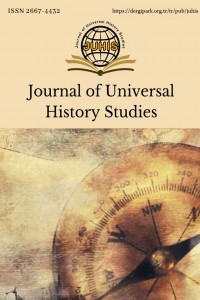Klasik Yunan Dünyasında Pers-Severlik Oluşumu
Pers Severlik, Akhaemenid, Yunanistan, Mit, Susa'nın Derikleri
The Foundation of Philo-Persianism in Classical Greek World
Philo-Persian, Achaemenid, Greece, Myth, Daric,
___
- [1] _____________ (1611). The King James Version Bible (KJV). The Church of England.
- [2] Abedi, F. (2018). “The Religious Policies of Artaxerxes II and the Appearance of a New Goddess in Anatolia” (in Persian), in: Proceeding of International Congress of Young Archaeologists, pp. 719-750. Tehran: Bonyad Iranshenasi.
- [3] Aelianus (1665). Various History. Translated by Thomas Stanely. London.
- [4] Apollodorus (1921). The Library. Translated by Sir James George Frazer. Loeb Classical Library Volumes 121 & 122. Cambridge and MA: Harvard University Press; London: William Heinemann Ltd.
- [5] Athenaeus (1854). The Deipnosophists, Or Banquet Of The Learned Of Athenaeus. London: Henry G. Bohn.
- [6] Badi, A. M. (1969). Les Greces et les Barbares (L autre face de l’historie). Lausanne: Payot.
- [7] Boffo, L. (1978). “La lettera di Dario a Gadata. I privilegi del tempio di Apollo a Magnesia sul Meandro”, in: BIDR, Terza Ser. XX, pp. 267-303.
- [8] Briant, P. (2002). From Cyrus to Alexander: A History of the Persian Empire. Translated by Peter T. Daniels. Winona Lake, Indiana: Eisenbrauns.
- [9] Burkert, W. (2001). Savage Energies: Lessons of Myth and Ritual in Ancient Greece. Chicago and London: The University of Chicago Press.
- [10] Burrell, B. (2004). Neokoroi: Greek Cities and Roman Empirers. Boston: Brill.
- [11] Carr, J. C. (2012). Sparta’s Kings. West Yorkshire: Pen and Sword Military.
- [12] Casson, S. (1914). “The Persian Expedition to Delphi”, in: CR, Vol. 28, No. 5, pp. 145-151.
- [13] Diodorus Siculus (1989). Diodorus of Sicily in Twelve Volumes, with an English Translation by C. H. Oldfather. Vol. 4-8. Cambridge and MA: Harvard University Press; London: William Heinemann, Ltd.
- [14] Dusinberre, E. R. M. (2003). Aspects of Empire in Achaemenid Sardis. Cambridge: Cambridge University Press.
- [15] Fehr, B. (1971). “Zur Geschichte des Apollonheiligtums von Didyma”, in: Marburger Winckelmann-Programm.1971-72, pp. 14-59.
- [16] Gaber, S. E. (1986). Regional Styles in Cypriote Sculpture: The Sculpture from Idalion. New York: Garland. Gjerstad.
- [17] Ghirshman, R. (1963). L‘Art de L‘Iran, Mede et Achemenide. Paris: Gallimard.
- [18] Graf, D. F. (1984). “Medism: The Origin and Significance of the Term”, in: JHS, Vol. 104, pp. 15-30.
- [19] Graf, F. (2009). Apollo. London and New York: Routledge.
- [20] Hammond, N. G. L. (1998). “The Branchidae at Didyma and in Sogdiana”, in: CQ, Vol. 48, No. 2, pp. 339-344.
- [21] Herodotus (1920). The Histories. Translated by A. D. Godley. Cambridge: Harvard University Press
- [22] Hesiod (1914). The Homeric Hymns and Homerica with an English Translation by Hugh G. Evelyn-White. Theogony. Cambridge and MA.:Harvard University Press; London: William Heinemann Ltd.
- [23] Jacobs, B. (2011). “Nemrud Dağı”, in: Encyclopædia Iranica, online edition, 2016, available at http://www.iranicaonline.org/articles/nemrud-dagi (accessed on 3 March 2018).
- [24] Josephus (1895). The Works of Flavius Josephus. Translated by William Whiston, A.M. Auburn and Buffalo: John E. Beardsley.
- [25] Lazenby, J. F. (1975). “Pausanias, Son of Kleombrotos”, in: Hermes, 103. Bd., H. 2, pp. 235-251.
- [26] Liddell, H. G. and Scott, R. (1889). An Intermediate Greek-English Lexicon. Oxford: Clarendon.
- [27] Pausanias (1918). Pausanias Description of Greece, with an English Translation by W. H. S. Jones, Litt. D. and H. A. Ormerod, M. A., in 4 Volumes. Cambridge and MA: Harvard University Press; London: William Heinemann Ltd.
- [28] Plato (1955). Plato in Twelve Volumes, Vol. 8. Translated by W.R.M. Lamb. Cambridge and MA: Harvard University Press; London: William Heinemann Ltd.
- [29] Plutarch (1917). Plutarch's Lives. with an English Translation by Bernadotte Perrin. Cambridge and MA. :Harvard University Press; London: William Heinemann Ltd.
- [30] Pliny the Elder (1855). The Natural History. ed. John Bostock, M.D., F.R.S. H.T. Riley, Esq., B.A.. London: Taylor and Francis.
- [31] Rhodes, P. J. (1970). “Thucydides on Pausanias and Themistocles”, in: Historia: Zeitschrift für Alte Geschichte, Bd. 19, H. 4, pp. 387-400.
- [32] Robert, L. (1953). “Le Sanctuaire d'Artémis à Amyzon”, in: CRAI, 97e année, N. 4, pp. 403-415.
- [33] Robert, L. and J. (1983). Fouilles d’Amyzon en Carie, I, Paris.
- [34] Schmidt, E. (1953), Persepolis I, Structures, Reliefs, Inscriptions. Chicago.
- [35] Schmitt, R. (1994). “Datis”, in: Encyclopædia Iranica, Vol. VII, Fasc. 2, pp. 126-127.
- [36] Schmitt, R. (2004). “Immortals”, in: Encyclopædia Iranica, Vol. XIII, Fasc. 1, pp. 2-3.
- [37] Sears, M. A. (2014). “Alexander and Ada Reconsidered”, in: CPh , Vol. 109, No. 3, pp. 211-221.
- [38] Sekunda, N. (1988). “Achaemenid Settlement In Caria, Lycia And Greater Phrygia”, in: Achaemenid History Vol 6 (Asia Minor And Egypt: Old Clutures In A New Empire). Leiden: Nederlands Instituut voor het Nabije Oosten, pp. 83-143.
- [39] Strabo (1924). The Geography of Strabo. ed. H. L. Jones, Cambridge and MA: Harvard University Press; London: William Heinemann Ltd.
- [40] Thucydides (1910). The Peloponnesian War. London: J. M. Dent; New York: E. P. Dutton.
- [41] Tyrwhitt, R. E. (1868). Esther and Ahasuerus: An Identification of the Persons so Named, Half-Vol. II.. Oxford and London: James Parker and CO..
- [42] Xenophon (1922). Xenophon in Seven Volumes, 3. ed. Carleton L. Brownson. Cambridge and MA: Harvard University Press, London: William Heinemann Ltd..
- Başlangıç: 2018
- Yayıncı: Sabit DOKUYAN
Mersin Şehir Merkezinde Bulunan Tarihi Kamu Binalarının Giriş Cepheleri (1850-1955)
Kerman’daki Malik Camii’nin Durumunun Analizi ve Selçuklu Mimarisinin Restorasyonunun Gerekliliği
Jamshid ROOSTA, Zohre MOQİMİZADE
Arşiv Belgeleri Işığında Mustafa Kemal Paşa’nın Askerlikten İstifa Süreci
Neslihan ALTUNCUOĞLU, Abdullah ERDOĞAN
İki Dünya Savaşında U Sınıfı Denizaltı Ticari Savaşı Çıkarımları
Klasik Yunan Dünyasında Pers-Severlik Oluşumu
Kilis Günlük Halk Gazetesindeki Haberlere Göre Hatay Meselesi
II. Dünya Savaşı Yıllarında Türkçü Dergiciliğin Bir Örneği Olarak Gök-Börü Dergisi
